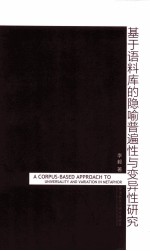

基于语料库的隐喻普遍性与变异性研究PDF电子书下载
- 电子书积分:11 积分如何计算积分?
- 作 者:李毅著
- 出 版 社:北京:外语教学与研究出版社
- 出版年份:2013
- ISBN:9787513534345
- 页数:283 页
Chapter One Introduction 1
1.1 Scope of the Study 1
1.2 Problems with Conceptual Metaphor Theory 5
1.2.1 The Big Puzzle:Variation in Metaphor 5
1.2.2 Criticisms of Conceptual Metaphor Theory 7
1.2.3 Methodological Drawbacks 9
1.3 Aims,Rationale and Significance of the Study 12
1.3.1 Aims of the Study 12
1.3.2 Rationale of the Study 14
1.3.3 Significance of the Study 17
1.4 Structure of the Dissertation 18
Chapter Two Literature Review 20
2.1 Metaphor and Embodiment 20
2.1.1 Metaphor in Cognitive Linguistics 20
2.1.2 Experientialism 25
2.1.3 Universality in Metaphor 30
2.2 Metaphor and Culture 35
2.2.1 Cultural Variation in Metaphor 36
2.2.2 Socioculturally Situated Cognition 40
2.3 Previous Studies on Metaphors of Inner Life 45
2.3.1 HEAD and HEART Metaphors of Inner Life in English 45
2.3.2 HEART Metaphors of Inner Life in Chinese 50
2.4 Corpus-based Studies on Metaphor 54
2.5 Summary 62
Chapter Three Theoretical Foundations 64
3.1 Main Tenets of Cognitive Linguistics 65
3.2 Conceptual Representation of Knowledge and Meaning 71
3.2.1 Categories,Concepts and Conceptualization 71
3.2.2 Frames,Domains and Idealized Cognitive Models 74
3.3 Complex Patterns of Semantic Extension 78
3.3.1 Conceptual Metaphor Theory 78
3.3.2 Primary Metaphor Theory 83
3.3.3 Conceptual Metonymy Theory 87
3.3.4 Interaction of Metaphor and Metonymy 94
3.4 Cognitive-Cultural Theory of Metaphor Variation 99
3.4.1 Dimensions of Cross-cultural Metaphor Variation 99
3.4.2 Causes of Metaphor Variation 102
Chapter Four Methodology 107
4.1 Paradigm of Metaphor Identification and Analysis 107
4.2 Analyzing Metaphor in Language 111
4.2.1 Operationalizing Metaphor Identification:MIP 111
4.2.2 Lexical Unit of Analysis 116
4.2.3 Dictionaries 118
4.2.4 Establishing Basic and Contextual Meanings 121
4.3 Analyzing Metaphor in Thought 123
4.3.1 Wordnet 124
4.3.2 WordNet and SUMO Method 126
4.3.3 Procedure for Data Analysis 131
4.4 Corpus Description 133
4.4.1 The English Corpus 133
4.4.2 The Chinese Corpus 134
4.5 Summary 135
Chapter Five Metaphors of Mental Life in English and Chinese 138
5.1 Metaphorical Expressions for Mental Life 139
5.1.1 The English Data 140
5.1.2 The Case of Head in Chinese 143
5.13 The Chinese Data 145
5.2 Conceptualizations of Head for Mental Life in English 147
5.2.1 HEAD AS A CONTAINER 149
5.2.2 HEAD AS AN OBJECT OF MANIPULATION 151
5.3 Conceptualizations of Heart for Mental Life in Chinese 159
5.3.1 HEART AS AN OBJECT OF MANIPULATION 162
5.3.2 HEART AS A LOCATION 174
5.3.3 HEART AS MOTION 175
5.3.4 HEART AS A CONTAINER 186
5.3.5 HEART AS LIGHT 187
5.4 Comparison and Discussion 192
5.5 Summary 194
Chapter Six Metaphors of Emotional Life in English and Chinese 197
6.1 Metaphorical Expressions for Emotiohal Life 198
6.1.1 The English Data 198
6.1.2 The Chinese Data 201
6.2 Conceptualizations of Heart for Emotional Life in English 201
6.2.1 HEART AS AN OBJECT 203
6.2.2 HEART AS A CONTAINER 211
6.2.3 HEART AS MOTION 213
6.3 Conceptualizations of Heart for Emotional Life in Chinese 219
6.3.1 HEART AS A CONTAINER 221
6.3.2 HEART AS MOTION 225
6.3.3 HEART AS AN OBJECT 231
6.3.4 HEART AS HEAT 236
6.3.5 HEART AS FOOD 239
6.4 Comparison and Discussion 242
6.5 Summary 245
Chapter Seven Conclusion 247
7.1 Linguistic and Conceptual Metaphors 249
7.2 Culture-specific Conceptualizations 251
7.3 Limitations and Possible Directions for Future Research 252
Bibliography 254
- 《比较文学变异学》王超著 2019
- 《汉语隐喻认知与fMRI神经成像》王小潞著 2019
- 《语料库驱动的短语配价型式研究》甄凤超著 2019
- 《内蒙古历史与文化汉英平行语料库构建研究》 2019
- 《映照的认知诗学研究 隐喻、象征和讽喻》朱瑞青著 2018
- 《语料库与学术英语研究》姜峰著 2019
- 《内隐学习在学习效率上的个体差异性研究》周铁民 2019
- 《文化认同和语言变异视角下的中国英语研究》曾剑平著 2017
- 《贵州峨眉山玄武岩差异性成矿研究》聂爱国,亢庚著 2014
- 《新核心大学英语听说教程 2》程寅分册主编 2011
- 《中风偏瘫 脑萎缩 痴呆 最新治疗原则与方法》孙作东著 2004
- 《水面舰艇编队作战运筹分析》谭安胜著 2009
- 《王蒙文集 新版 35 评点《红楼梦》 上》王蒙著 2020
- 《TED说话的力量 世界优秀演讲者的口才秘诀》(坦桑)阿卡什·P.卡里亚著 2019
- 《燕堂夜话》蒋忠和著 2019
- 《经久》静水边著 2019
- 《魔法销售台词》(美)埃尔默·惠勒著 2019
- 《微表情密码》(波)卡西亚·韦佐夫斯基,(波)帕特里克·韦佐夫斯基著 2019
- 《看书琐记与作文秘诀》鲁迅著 2019
- 《酒国》莫言著 2019
